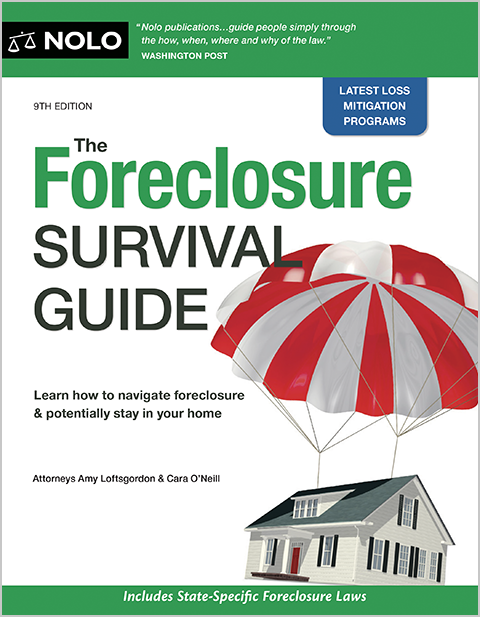Learn about mortgage assistance for veterans, including the new Partial Claim Program, and other ways to avoid foreclosure if you have a VA home loan.
On July 30, 2025, President Trump signed the VA Home Loan Program Reform Act (H.R. 1815) into law. This law establishes a Partial Claim Program to help veterans avoid a foreclosure. The Partial Claim Program allows homeowners who are late in mortgage payments to tack those overdue payments on the end of a VA-guaranteed loan, to be repaid when the homeowner refinances, sells the home, or pays off the mortgage.
This Act also says the VA must prescribe loss mitigation procedures to help prevent foreclosures. Active servicemembers, veterans, and surviving spouses who have a VA-guaranteed or direct mortgage loan get access to special mortgage relief programs, including loan modification and refinancing options.
In addition, veterans who need mortgage assistance can get free counseling to help avoid foreclosure.
- VA Home Loan Assistance Programs
- Partial Claim Program for Overdue VA Loan Payments
- Refinancing Your VA Loan With a Streamline Refinance
- Loss Mitigation Options for VA Loans
- Extra Time to Arrange a Private Sale
- What Is the VA "Refund" Program?
- Options for Giving Up the Home: Short Sales and Deeds in Lieu of Foreclosure
- An Assumption Might Be a Possibility
- How to Apply for VA Assistance for Mortgage Payments
- Resources and Financial Counseling
VA Home Loan Assistance Programs
Under the VA Home Loan Program Reform Act, the holder of a VA-guaranteed loan (the lender) must go through a mandatory loss mitigation sequence in which the lender offers loss mitigation options to a homeowner who's behind in mortgage payments, including an option to enter into a partial claim agreement, to help prevent a foreclosure.
Veterans struggling to make mortgage payments on a VA loan might also be able to avoid foreclosure by:
- refinancing their home loan with a VA streamline refinance loan (an Interest Rate Reduction Refinance Loan)
- working out another loss mitigation option, like a repayment plan, special forbearance, or loan modification
- getting extra time to arrange a private sale of the property, or
- "refunding" the loan.
Mortgage assistance programs for veterans also include completing a compromise sale (a short sale) or a deed in lieu of foreclosure.
Partial Claim Program for Overdue VA Loan Payments
A "partial claim" is an interest-free, no-payment loan to get caught up on overdue mortgage payments. The VA's Partial Claim Program is available for VA loans on primary residences that are in default or at imminent risk of default.
Under the VA's Partial Claim Program, the VA pays off past-due amounts you owe to the lender, bringing the first mortgage current. That way, you can start making your mortgage payments again and avoid foreclosure. The amount the VA pays then becomes a subordinate mortgage on your home. But you don't have to make any payments on it. You pay it back when you refinance, sell the property, or pay off the first mortgage. However, if you default on a loan for which you got a partial claim, you're liable for any loss the VA incurs that results from the default, such as a deficiency judgment.
Generally, the amount of a partial claim can't exceed 25% of the unpaid principal balance of the loan on the date when the partial claim is made. However, in the case of a homeowner who failed to make payments on a VA-guaranteed loan from March 1, 2020 to May 1, 2025, the amount of a partial claim can't exceed 30% of the unpaid principal balance of the loan on the date when the partial claim is made.
Also, you can get an additional partial claim if you failed to make payments on a VA-guaranteed loan during a presidentially-declared disaster or within 120 days following the disaster.
Refinancing Your VA Loan With a Streamline Refinance
A VA streamline refinance is officially known as an "Interest Rate Reduction Refinance Loan" (IRRRL). An IRRRL is a VA-guaranteed loan that lowers your interest rate, decreasing the monthly principal and interest payments.
Who's Eligible for an IRRRL?
If you have a VA-guaranteed loan, you can apply for an IRRRL. The IRRRL must be in a first-lien position, so if you have a second mortgage, that lien holder must agree to subordinate its loan.
Your Loan Entitlement
An IRRRL will reuse the entitlement you originally used. (VA loan entitlement is the amount for which the VA will guarantee a loan. Most lenders will lend up to four times the amount of the total entitlement. The basic entitlement available to an eligible veteran is $36,000.)
In other words, an IRRRL is a VA-to-VA refinance that reuses the veteran-applicant's entitlement.
Refinancing Property That's "Underwater"
Generally, an IRRRL doesn't require an appraisal, credit information, or underwriting. So, you can refinance an underwater home. The basis for the loan is the existing VA loan, not the property's current market value.
You Don't Have to Live in the Home
Additionally, you don't have to currently occupy the property to qualify for an IRRRL. But it might be easier to get approved if you live there. You do need to certify that you previously occupied the home, though.
Cost of an IRRRL
Veterans using the VA Home Loan Guaranty benefit generally must pay a funding fee. The funding fee is a percentage of the loan amount, which varies based on the type of loan and your military category, as well as if you're a first-time or subsequent loan user and whether you make a down payment.
You don't have to pay the fee if you are:
- receiving VA compensation for a service-connected disability
- entitled to receive compensation for a service-connected disability if you didn't receive retirement or active duty pay or
- you are the surviving spouse of a veteran who died in service or from a service-connected disability.
The IRRRL can be completed with no money out of pocket by including all costs in the new loan or by making the new loan at an interest rate high enough to enable the lender to pay the costs. The funding fee can be paid in cash at closing or added to the new loan.
Loan proceeds may only be applied to paying off the existing VA loan and the costs of obtaining or closing the IRRRL. You can't get any cash out from the loan proceeds. To learn more about an IRRRL, visit the U.S. Department of Veterans Affairs website.
Loss Mitigation Options for VA Loans
Loss mitigation options are also available to help veterans avoid foreclosure on delinquent loans. The main options for VA loans are:
- Repayment plans. You pay the regular monthly payment and an agreed-upon portion of the arrearage to get caught up on the loan, usually over three months or more.
- Special forbearance. The servicer agrees to suspend all payments or accept reduced payments for a specific period, typically three or four months.
- Loan modifications. In a loan modification, the servicer generally adds the unpaid payments, interest, taxes, insurance, certain assessments (like water and sewer charges), and sometimes legal fees and foreclosure costs to the principal balance of the loan. The new principal balance is then amortized, usually with a different interest rate, which lowers the mortgage payments. Federal law permits the terms of any VA-guaranteed loan to be modified without the prior approval of the VA if specific regulatory conditions are satisfied. (38 C.F.R. § 36.4315 (2025).) You might qualify for a traditional modification, streamline modification, special disaster modification, or another type of available modification.
Extra Time to Arrange a Private Sale
If you'd like to sell your home, this option lets you delay a foreclosure sale so you have time to complete a sale.
What Is the VA "Refund" Program?
If you're having trouble paying your mortgage and facing foreclosure, the VA has the discretionary authority to purchase the loan from a private lender and take over the servicing of that loan. This process is called "refunding," which in this sense means "to fund again." The VA will then work with you to avoid foreclosure.
Refunding is rare. But if you're in default on your mortgage payments and you can't get a forbearance, repayment plan, or loan modification even though you can make the mortgage payments (or will have the ability to make them soon), you might qualify.
To find out about a potential refund, call your servicer. You can also contact a VA regional center to learn more.
Options for Giving Up the Home: Short Sales and Deeds in Lieu of Foreclosure
In a "compromise sale," the homeowner sells the property to a third party for an amount insufficient to pay off the loan. The servicer releases the lien and waives the deficiency in exchange for the sale proceeds. (A "compromise sale" is what the VA calls a short sale.)
With a deed in lieu of foreclosure, the homeowner voluntarily transfers the property to the holder of the VA-guaranteed loan.
However, you should be aware that completing a compromise sale or a deed in lieu of foreclosure could result in a loss or reduction in your future home loan benefit.
An Assumption Might Be a Possibility
Instead of selling your home for less than you owe or deeding it to the holder, you might be able to sell the property and have the buyer take over your mortgage loan.
How to Apply for VA Assistance for Mortgage Payments
Contact your loan servicer directly to learn what options are available in your particular situation. It's also a good idea to talk to a (free) HUD-approved housing counselor.
Resources and Financial Counseling
VA personnel also assist veterans who are having problems making their mortgage payments.
Veterans With VA Loans (Get Expert Help From a VA Loan Technician)
If you're a veteran with a VA loan, the VA can provide a technician who can intervene with the servicer on your behalf and help you work with your servicer to explore all options to avoid foreclosure, as well as conduct financial counseling. If the servicer fails to exhaust the alternatives discussed in this article, contact one of the VA Regional Loan Centers.
You may also contact a VA loan technician at 877-827-3702 (TTY: 711).
Veterans With Loans That Aren't VA-Guaranteed
If you're a veteran, but the VA doesn't guarantee or service your loan, the VA doesn't have the legal authority to intervene with the servicer on your behalf. However, you can call your nearest Regional Loan Center to speak to a technician who can advise you on approaches to take with your servicer.
Financial Counseling for Veterans to Avoid Foreclosure
You can get free help and counseling from a HUD-approved housing counselor, no matter what type of loan you have.
Get More Help Avoiding Foreclosure of a VA Home Loan
Go to the Department of Veterans Affairs website for more information about what to do if you're struggling with your mortgage payments.
- VA Home Loan Assistance Programs
- Partial Claim Program for Overdue VA Loan Payments
- Refinancing Your VA Loan With a Streamline Refinance
- Loss Mitigation Options for VA Loans
- Extra Time to Arrange a Private Sale
- What Is the VA "Refund" Program?
- Options for Giving Up the Home: Short Sales and Deeds in Lieu of Foreclosure
- An Assumption Might Be a Possibility
- How to Apply for VA Assistance for Mortgage Payments
- Resources and Financial Counseling

